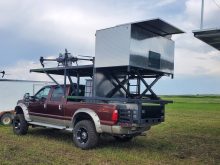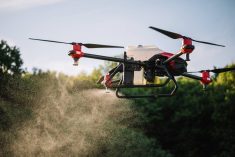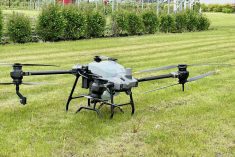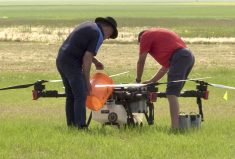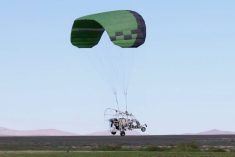Should you add a UAV to your farm fleet or should you just hire someone with their own to do the flying for you? That’s a question farmers looking to collect the kind of data a UAV can capture will have to consider. At three to five dollars per acre to have a custom operator fly over fields and create images, it may make sense for large farmers to buy their own.
“Depending on how much labour you have at home, that’s really what it comes down to,” says Markus Weber, president of AgEagle Canada, a UAV retailer. “If they have the time between seeding and spraying to be flying — that’s really the crucial time for flying — then you fly your own.”
Read Also

Claas brings 1000 Series SP forage harvesters to Canada
In mid-August, Claas unveiled its new line of Jaguar forage harvesters at an event in Visalia, California, deep in the heart of that state’s dairy region.
The alternative is to hire one of the increasing number of custom operators who will fly their own UAVs and capture data from your fields for you.
“There is a whole industry that is starting to develop over just flying these things,” Weber adds. “They buy the wing, then resell the imagery to the agronomist or farmer.”
But for those who decide they want their own air force, they should consider making some efforts to earn their wings first. Federal regulations may require proof they have the training needed to safely operate a UAV when applying for a Special Flight Operations Certificate (SFOC), which is required for most types of flights by the kinds of larger UAVs typically used in agriculture.
“Even if Transport Canada didn’t require it, it makes sense to go through that kind of training,” says Weber. “Safety means it’s going to fly a lot longer, you’re not going to fly it into other things. It makes sense to go through that kind of training.”
Some retailers offer pilot training with the purchase of a UAV. Alternatively, fledgling pilots can attend a one and one-half day ground school at a place like the Canadian Centre for Unmanned Vehicle Systems in Southern Alberta (CCUVS.com).
“There are three different types of flights,” explains Weber. “The standard is you need a Special Operations Certificate (SFOC). There is paperwork, and you apply to Transport Canada.”
However, the other two types of flights don’t require a SFOC. One is if the UAV is under 2.5 kilograms. It then qualifies for an exemption. But that is a pretty small aircraft and not likely suitable for ag data collection.
“You can fly, as long as you comply with the rules, you don’t even notify Transport Canada,” he adds. “For anything over 2.5 kilograms there are notification requirements.”
The third type of flight applies to farmers that are more than five miles away from a built-up area. They could qualify for an exemption allowing them to fly without a SFOC if they don’t fly higher than 300 feet.





